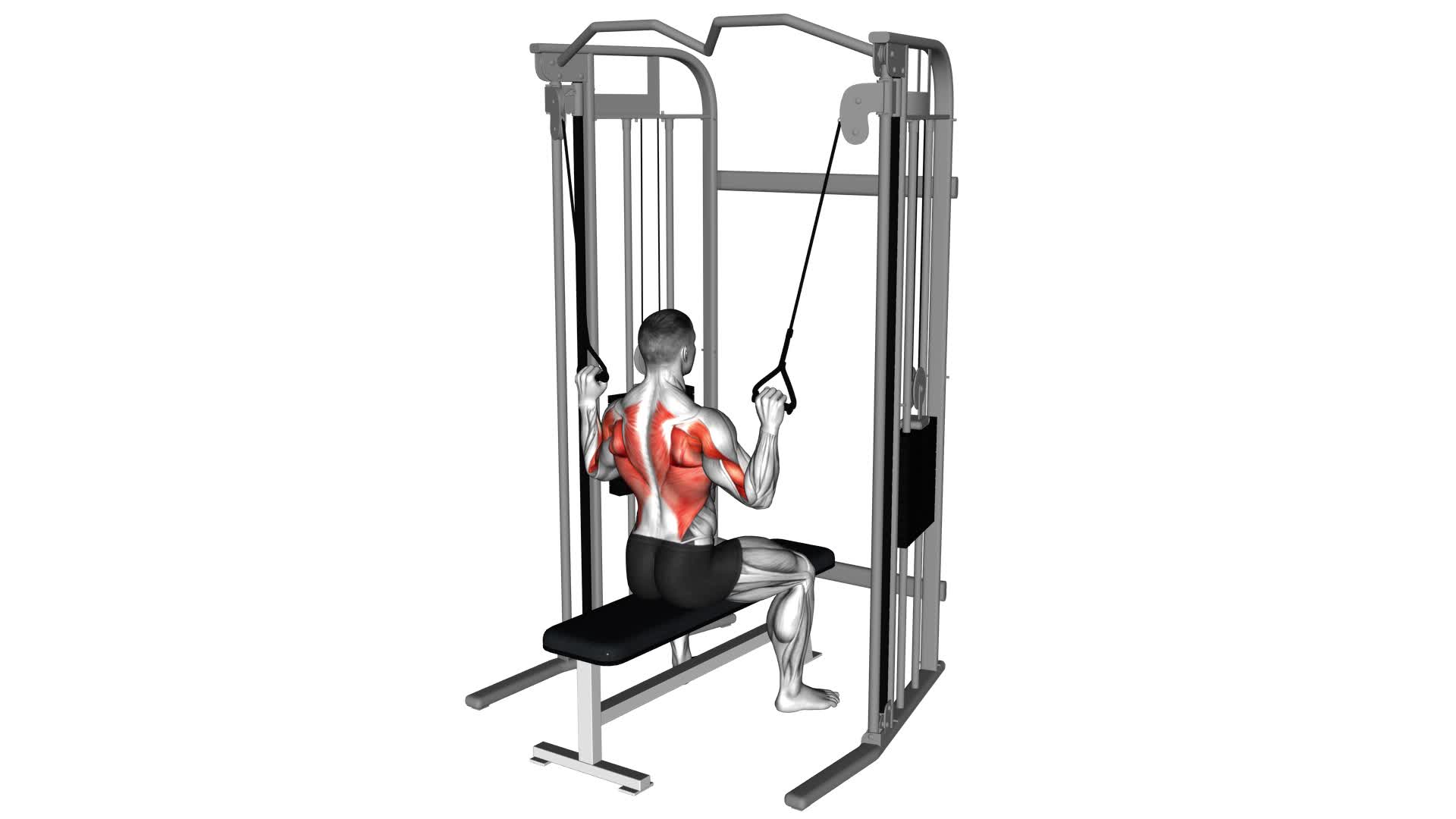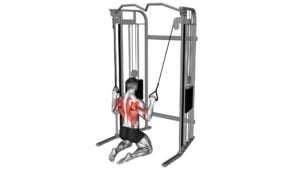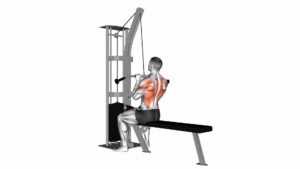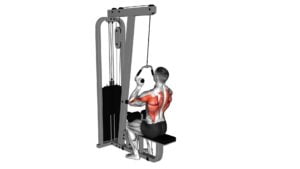Cable Twin Handle Parallel Grip Lat Pulldown – Video Exercise Guide & Tips

Are you looking to strengthen your back and build upper body strength? The Cable Twin Handle Parallel Grip Lat Pulldown is the exercise for you! In this video exercise guide, we'll show you the proper technique and form to get the most out of this exercise.
Watch This Exercise Video
We'll also cover common mistakes to avoid and provide variations and modifications to suit your fitness level. Follow our tips and maximize the effectiveness of the Cable Twin Handle Parallel Grip Lat Pulldown.
Key Takeaways
- The cable twin handle parallel grip lat pulldown targets the muscles in the back, specifically the latissimus dorsi.
- It allows for a greater range of motion compared to other lat pulldown variations.
- The neutral hand position reduces strain on the wrists and elbows.
- The exercise enhances muscle definition and strength in the back, engages multiple muscle groups, builds upper body strength, improves posture and back stability, and enhances grip strength and overall pulling power.
Benefits of the Cable Twin Handle Parallel Grip Lat Pulldown
You can experience significant muscle growth and upper body strength gains by incorporating the Cable Twin Handle Parallel Grip Lat Pulldown into your workout routine. This exercise targets the muscles in your back, specifically the latissimus dorsi, or lats, which are responsible for pulling movements. The parallel grip allows for a neutral hand position, reducing strain on the wrists and elbows and providing a more comfortable and effective workout.
One of the main benefits of the Cable Twin Handle Parallel Grip Lat Pulldown is that it allows for a greater range of motion compared to other lat pulldown variations. This means that you can fully engage and activate your back muscles, resulting in improved muscle definition and strength. Additionally, the parallel grip variation targets the muscles from a different angle, providing a unique stimulus for growth.
Another benefit of the Cable Twin Handle Parallel Grip Lat Pulldown is its versatility. By adjusting the weight and grip width, you can target different areas of your back and stimulate different muscle fibers. For example, a wider grip will engage the outer portion of your lats, while a narrower grip will target the middle portion. By incorporating different grip variations into your routine, you can ensure balanced muscle development and avoid plateaus in your progress.
Proper Technique and Form for the Cable Twin Handle Parallel Grip Lat Pulldown
How can you ensure proper technique and form for the Cable Twin Handle Parallel Grip Lat Pulldown?
It's important to maintain proper form during this exercise to maximize its effectiveness and prevent injury. Here are some tips to help you perform the Cable Twin Handle Parallel Grip Lat Pulldown correctly.
Firstly, make sure you're using the appropriate weight for your fitness level. Start with a weight that challenges you but allows you to maintain proper form throughout the exercise.
To begin, sit down on the seat and adjust the thigh pads to secure your legs in place. Grab the handles with a parallel grip, palms facing each other. Keep your back straight and engage your core throughout the movement.
As you pull the handles down towards your chest, focus on squeezing your shoulder blades together. Avoid using your biceps to pull the weight down. Instead, use your back muscles to initiate the movement.
Proper breathing technique is also crucial during the Cable Twin Handle Parallel Grip Lat Pulldown. Inhale as you extend your arms upward, and exhale as you pull the handles down towards your chest.
Remember to perform the exercise in a controlled manner, avoiding any jerking or swinging motions. If you find it difficult to maintain proper form, consider using alternatives such as the assisted pull-up machine or the seated cable row.
Common Mistakes to Avoid During the Cable Twin Handle Parallel Grip Lat Pulldown
To ensure proper technique and form for the Cable Twin Handle Parallel Grip Lat Pulldown, it's important to avoid common mistakes. Here are three key mistakes to watch out for:
- Using too much momentum: One common mistake is relying on momentum to pull the handles down instead of using controlled muscle strength. This not only reduces the effectiveness of the exercise but also increases the risk of injury. Focus on engaging your back muscles and pulling the handles down in a slow and controlled manner.
- Leaning back excessively: Another mistake is leaning back excessively while performing the exercise. This can put excessive strain on your lower back and take away the emphasis from your targeted muscles. Maintain an upright posture throughout the movement and avoid leaning back too far.
- Gripping the handles too tightly: Holding the handles too tightly can lead to unnecessary tension in your forearms, wrists, and shoulders. Instead, aim for a relaxed grip that allows your back muscles to do the work. Focus on squeezing your shoulder blades together as you pull the handles down.
Variations and Modifications for the Cable Twin Handle Parallel Grip Lat Pulldown
To add variety and challenge to your Cable Twin Handle Parallel Grip Lat Pulldown workout, consider incorporating different variations and modifications.
One variation you can try is the underhand grip, where you hold the handles with your palms facing up. This targets your biceps more and can help improve your overall arm strength.
Another variation is the wide grip, where you place your hands wider than shoulder-width apart on the handles. This targets your upper back and shoulders more, providing a different stimulus to those muscles.
If you want to increase the difficulty of the exercise, you can add weight by using a weight vest or attaching a resistance band to the cable machine. This will help you build more strength and muscle. Remember to start with lighter weights and gradually increase the resistance as you get stronger.
By incorporating these variations and modifications into your Cable Twin Handle Parallel Grip Lat Pulldown routine, you can keep your workouts fresh and continue challenging your muscles.
Now, let's move on to some tips for maximizing the effectiveness of the cable twin handle parallel grip lat pulldown.
Tips for Maximizing the Effectiveness of the Cable Twin Handle Parallel Grip Lat Pulldown
To maximize the effectiveness of your Cable Twin Handle Parallel Grip Lat Pulldown, focus on maintaining proper form and engaging your back muscles throughout the entire exercise. Here are some tips to help you maximize muscle engagement and get the most out of this exercise:
- Grip positions: Experiment with different grip positions to target different muscles in your back. Try a wide grip to focus on your lats, a close grip to target your rhomboids and middle back, or a neutral grip to engage your biceps and lower traps.
- Pull with your elbows: Instead of using your hands to pull the handles down, focus on pulling with your elbows. This will help you engage your back muscles more effectively and prevent your biceps from taking over.
- Squeeze your shoulder blades: At the bottom of the movement, squeeze your shoulder blades together to fully engage your back muscles. This will help you achieve a deeper contraction and maximize the effectiveness of the exercise.
By following these tips and incorporating alternative grip positions, you can maximize muscle engagement and get the most out of your Cable Twin Handle Parallel Grip Lat Pulldown.
Remember to always listen to your body and adjust the weight and intensity as needed.
Frequently Asked Questions
What Are Some Alternative Exercises That Target the Same Muscle Groups as the Cable Twin Handle Parallel Grip Lat Pulldown?
Looking for alternative exercises that target the same muscle groups as the cable twin handle parallel grip lat pulldown?
There are a few options you can try.
One alternative is the bent-over row, which works your back muscles and biceps.
Another option is the seated cable row, which also targets the back and biceps while providing a different range of motion.
Lastly, the pull-up is a challenging exercise that engages your back and arms.
How Many Sets and Reps Should I Do for the Cable Twin Handle Parallel Grip Lat Pulldown?
For the cable twin handle parallel grip lat pulldown, you should aim for 3 to 4 sets of 8 to 12 reps. This will help you build strength and muscle in your back and arms.
Don't forget to warm up before starting and use proper form throughout the exercise.
This variation of the lat pulldown targets your back muscles while also engaging your biceps.
The benefits include improved posture, increased upper body strength, and better overall back development.
Can I Use a Different Type of Handle for the Cable Twin Handle Parallel Grip Lat Pulldown?
Yes, you can use a different type of handle for the cable twin handle parallel grip lat pulldown. There are various handle options available, such as a wide grip, narrow grip, or V-bar handle.
Using different handles can provide you with a range of benefits for your lat pulldown exercise. It can help target different areas of your back, improve grip strength, and add variety to your workout routine.
Is the Cable Twin Handle Parallel Grip Lat Pulldown Suitable for Beginners?
Yes, the cable twin handle parallel grip lat pulldown is suitable for beginners.
It's important to focus on proper form and technique when performing this exercise. Make sure to keep your back straight and engage your core.
This exercise is great for strengthening your back and improving your posture.
How Often Should I Incorporate the Cable Twin Handle Parallel Grip Lat Pulldown Into My Workout Routine?
To incorporate the cable twin handle parallel grip lat pulldown into your workout routine, you should aim to do it at least twice a week.
This exercise is great for targeting your back muscles and can provide variety by incorporating different grip variations.
The cable twin handle parallel grip lat pulldown can help improve your overall upper body strength and posture.
It's important to ensure proper form and start with a weight that's manageable for you.
Conclusion
In conclusion, the Cable Twin Handle Parallel Grip Lat Pulldown is an effective exercise for targeting the muscles in the back and arms. By using proper technique and form, you can maximize the effectiveness of this exercise and avoid common mistakes.
Additionally, there are variations and modifications available to challenge yourself and keep your workouts interesting.
Incorporating the Cable Twin Handle Parallel Grip Lat Pulldown into your routine can help improve your strength and overall fitness.

Author
Years ago, the spark of my life’s passion ignited in my mind the moment I stepped into the local gym for the first time. The inaugural bead of perspiration, the initial endeavor, the very first surge of endorphins, and a sense of pride that washed over me post-workout marked the beginning of my deep-seated interest in strength sports, fitness, and sports nutrition. This very curiosity blossomed rapidly into a profound fascination, propelling me to earn a Master’s degree in Physical Education from the Academy of Physical Education in Krakow, followed by a Sports Manager diploma from the Jagiellonian University. My journey of growth led me to gain more specialized qualifications, such as being a certified personal trainer with a focus on sports dietetics, a lifeguard, and an instructor for wellness and corrective gymnastics. Theoretical knowledge paired seamlessly with practical experience, reinforcing my belief that the transformation of individuals under my guidance was also a reflection of my personal growth. This belief holds true even today. Each day, I strive to push the boundaries and explore new realms. These realms gently elevate me to greater heights. The unique combination of passion for my field and the continuous quest for growth fuels my drive to break new ground.







